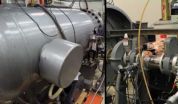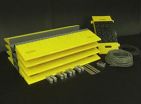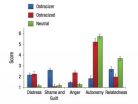(Press-News.org)
VIDEO:
NASA scientists at the Goddard Cosmic Ice Lab are studying a kind of chemistry almost never found on Earth. The extreme cold, hard vacuum, and high radiation environment of space...
Click here for more information.
Behind locked doors, in a lab built like a bomb shelter, Perry Gerakines makes something ordinary yet truly alien: ice. This isn't the ice of snowflakes or ice cubes. No, this ice needs such intense cold and low pressure to form that the right conditions rarely, if ever, occur naturally on Earth. And when Gerakines makes the ice, he must keep the layer so microscopically thin it is dwarfed by a grain of pollen.
These ultrathin layers turn out to be perfect for recreating some of the key chemistry that takes place in space. In these tiny test tubes, Gerakines and his colleagues in the Cosmic Ice Lab at NASA's Goddard Space Flight Center in Greenbelt, Md., can reproduce reactions in ice from almost any time and place in the history of the solar system, including some that might help explain the origin of life.
"This is not the chemistry people remember from high school," says Reggie Hudson, who heads the Cosmic Ice Lab. "This is chemistry in the extreme: bitter cold, harsh radiation and nearly non-existent pressure. And it's usually taking place in gases or solids, because generally speaking, there aren't liquids in interstellar space."
The Cosmic Ice Lab is one of a few laboratories worldwide where researchers have been studying the ultracool chemistry of cosmic ice. With its powerful particle accelerator, the Goddard lab has the special ability to mimic almost any kind of solar or cosmic radiation to drive these reactions. And that lets them dig deep to study the chemistry of ice below the surface of planets and moons as well as ice in space.
Recipe for disorder
In a vacuum chamber about the size of a lunchbox, Gerakines recreates a little patch of deep space, in all its extremes. He pumps out air until the pressure inside drops to a level a billion times lower than normal for Earth, then chills the chamber to minus 433 degrees Fahrenheit (15 kelvins). To get ice, all that remains is to open a valve and let in water vapor.
The instant the sprightly vapor molecules enter the chamber they are literally frozen in their tracks. Still pointing every which way, the molecules are transformed immediately from their gaseous state into the disorderly solid called amorphous ice. Amorphous ice is exactly the opposite of the typical ice on Earth, which forms perfect crystals like those that make up snowflakes or frost needles. These crystals are so orderly and predictable that this ice is considered a mineral, complete with a rating of 2.5 on the Mohs scale of hardness—the same rating as a fingernail.
Though almost unheard of on Earth, amorphous ice is so widespread in interstellar space that it could be the most common form of water in the universe. Left over from the age when the solar system was born, it is scattered across vast distances, often as particles no bigger than grains of dust. It's also been spotted in comets and icy moons.
The secret to making amorphous ice in the lab, Gerakines finds, is to limit the layer to a depth of about half a micrometer—thinner than a strand of spider's silk.
"Water is such a good insulator that if the ice gets too thick, only the bottom of the sample, closer to the cooling source, will stay sufficiently cold," says Gerakines. "The ice on top will get warm enough to crystallize."
The superthin ice can be spiked with all kinds of interesting chemicals found in space. One set of chemicals that Gerakines works with is amino acids, which are key players in the chemistry of life on Earth. Researchers have spent decades identifying a whole smorgasbord of amino acids in meteorites (including some involved in life), as well as one found in a sample taken from a comet.
"And because water is the dominant form of frozen material in the interstellar medium and outer solar system," says Gerakines, "any amino acids out there are probably in contact with water at some point."
For his current set of experiments, Gerakines makes three kinds of ice, each spiked with an amorphous form of an amino acid (either glycine, alanine or phenylalanine) that is found in proteins.
Gimme shelter
The real action begins when Gerakines hits the ice with radiation.
Earlier studies by other researchers have looked at ice chemistry using ultraviolet light. Gerakines opts instead to look at cosmic radiation, which can reach ice hidden below the surface of a planet or moon. To mimic this radiation, he uses a proton beam from the high-voltage particle accelerator, which resides in an underground room lined with immense concrete walls for safety.
With the proton beam, a million years' worth of damage can be reproduced in just half an hour. And by adjusting the radiation dose, Gerakines can treat the ice as if it were lying exposed or buried at different depths of soil in comets or icy moons and planets.
He tests the three kinds of water-plus-amino-acid ice and compares them to ice made from amino acids only. Between blasts, he checks the samples using a "molecular fingerprinting" technique called spectroscopy to see if the amino acids are breaking down and chemical by-products are forming.
As expected, more and more of the amino acids break down as the radiation dose adds up. But Gerakines notices that the amino acids last longer if the ice includes water than if they are left on their own. This is odd, because when water breaks down, one of the fragments it leaves behind is hydroxyl (OH), a chemical well-known for attacking other compounds.
The spectroscopy confirms that some OH is being produced. But overall, says Gerakines, "the water is essentially acting like a radiation shield, probably absorbing a lot of the energy, the same way a layer of rock or soil would."
When he repeats the experiments at two higher temperatures, he is surprised to find the acids fare even better. From these preliminary measurements, he and Hudson calculate how long amino acids could remain intact in icy environments over a range of temperatures.
"We find that some amino acids could survive tens to hundreds of millions of years in ice near the surface of Pluto or Mars and buried at least a centimeter [less than half an inch] deep in places like the comets of the outer solar system," says Gerakines. "For a place that gets heavy radiation, like Europa, they would need to be buried a few feet." (These findings were reported in the journal Icarus in August 2012.)
"The good news for exploration missions," says Hudson, "is it looks as if these amino acids are actually more stable than anybody realized at temperatures typical of places like Pluto, Europa and even Mars."
INFORMATION:
The Cosmic Ice Lab is part of the Astrochemistry Laboratory in Goddard's Solar System Exploration Division and is funded in part by the Goddard Center for Astrobiology and the NASA Astrobiology Institute.
NASA Goddard lab works at extreme edge of cosmic ice
2013-03-05
ELSE PRESS RELEASES FROM THIS DATE:
Sometimes, the rubber meets the road when you don't want it to
2013-03-05
Back in 2010, the ideas behind a squid's sticky tendrils and Spiderman's super-strong webbing were combined to create a prototype for the first remote device able to stop vehicles in their tracks: the Safe, Quick, Undercarriage Immobilization Device (SQUID). At the push of a button, spiked arms shot out and entangled in a car's axles—bringing a racing vehicle to a screeching halt.*
The need to stop vehicles remotely was identified by the law enforcement community. With funding from Homeland Security's Science & Technology Directorate, and the expertise of the engineers ...
Colon cancer screening doubles with new e-health record use
2013-03-05
SEATTLE—Researchers used electronic health records to identify Group Health patients who weren't screened regularly for cancer of the colon and rectum—and to encourage them to be screened. This centralized, automated approach doubled these patients' rates of on-time screening—and saved health costs—over two years. The March 5 Annals of Internal Medicine published the randomized controlled trial.
"Screening for colorectal cancer can save lives, by finding cancer early—and even by detecting polyps before cancer starts," said study leader Beverly B. Green, MD, MPH. "But ...
Study uncovers enzyme's double life, critical role in cancer blood supply
2013-03-05
Studied for decades for their essential role in making proteins within cells, several amino acids known as tRNA synthetases were recently found to have an unexpected – and critical – additional role in cancer metastasis in a study conducted collaboratively in the labs of Karen Lounsbury, Ph.D., University of Vermont professor of pharmacology, and Christopher Francklyn, Ph.D., UVM professor of biochemistry. The group determined that threonyl tRNA synthetase (TARS) leads a "double life," functioning as a critical factor regulating a pathway used by invasive cancers to induce ...
Fishers near marine protected areas go farther for catch but fare well
2013-03-05
VANCOUVER, Wash.—Fishers near marine protected areas end up traveling farther to catch fish but maintain their social and economic well-being, according to a study by fisheries scientists at Washington State University and in Hawaii.
The study, reported in the journal Biological Conservation, is one of the first to look closely at how protected areas in small nearshore fisheries can affect where fishers operate on the ocean and, as a consequence, their livelihood.
"Where MPAs are located in relation to how fishers operate on the seascape is critical to understand for ...
'Mean girls' be warned: Ostracism cuts both ways
2013-03-05
If you think giving someone the cold shoulder inflicts pain only on them, beware. A new study shows that individuals who deliberately shun another person are equally distressed by the experience.
"In real life and in academic studies, we tend to focus on the harm done to victims in cases of social aggression," says co-author Richard Ryan, professor of clinical and social psychology at the University of Rochester. "This study shows that when people bend to pressure to exclude others, they also pay a steep personal cost. Their distress is different from the person excluded, ...
Domestic violence in New Jersey
2013-03-05
Domestic violence in New Jersey
Article provided by Keith, Winters & Wenning, L.L.C.
Visit us at http://www.kwwlawfirm.com
Everyone thought the story was over. In 2009 pop sensation Rihanna was brutally assaulted by her then boyfriend Chris Brown. The singer stated that she ended the relationship and the media applauded her brave move. She became a role model for domestic violence victims around the world.
That is, until January of 2013 when the star publicly announced that she had rekindled her relationship with her convicted abuser. Unfortunately, Rihanna's ...
Revocable living trust: Is it right for you?
2013-03-05
Revocable living trust: Is it right for you?
Article provided by Anderson and Associates, P.C.
Visit us at http://www.davidandersonlaw.com/
Most people consider wills for estate planning; however, this is not the only option. In addition to avoiding probate, a revocable living trust may offer you significant before-death and after-death advantages.
In general, a trust involves three parties: the creator, the trustee or trustees (who agree to manage the assets according to the terms of the trust) and the beneficiary or beneficiaries. Something as miniscule as ...
Why borrowing against your 401(k) may be a bad idea
2013-03-05
Why borrowing against your 401(k) may be a bad idea
Article provided by Law Offices of Brian Barta
Visit us at http://www.brianbartalaw.com
Twenty-five percent of Americans have made early withdrawals from their retirement plans using a 401(k) loan, according to a recent report by online financial guidance service HelloWallet. However, many people who tap into their retirement funds may do so without being fully aware of the risks involved in doing so.
Particularly in the aftermath of the recent recession, people who borrow against their retirement savings often ...
Changes for teen distracted driving laws in California?
2013-03-05
Changes for teen distracted driving laws in California?
Article provided by Law Offices of Joshua Katz and Bozman-Moss & Watson
Visit us at http://www.sonomalegal.com
One of the most highly-anticipated moments for any teen is when he or she finally receives a driver's license. Once licensed, these drivers no longer have to rely upon mom or dad for transportation. They can go where they want to go, when they want to go there.
However, the freedom that a new driver's license provides requires that teens practice safe driving habits. Even after passing the test, ...
Obamacare may curb health care spending, lead to more investigations
2013-03-05
Obamacare may curb health care spending, lead to more investigations
Article provided by Rivas Goldstein LLP
Visit us at http://www.rivasgoldstein.com/
A new government report states the massive increases in health care costs are starting to slow. In fact, according to Susan Dentzer, an expert with the well respected journal Health Affairs, 2009 and 2010 showed the slowest increase in health care spending in 51 years.
The motivator for this change is a controversial topic in Washington. According to some, the change is due to the economic downtown. People simply ...



